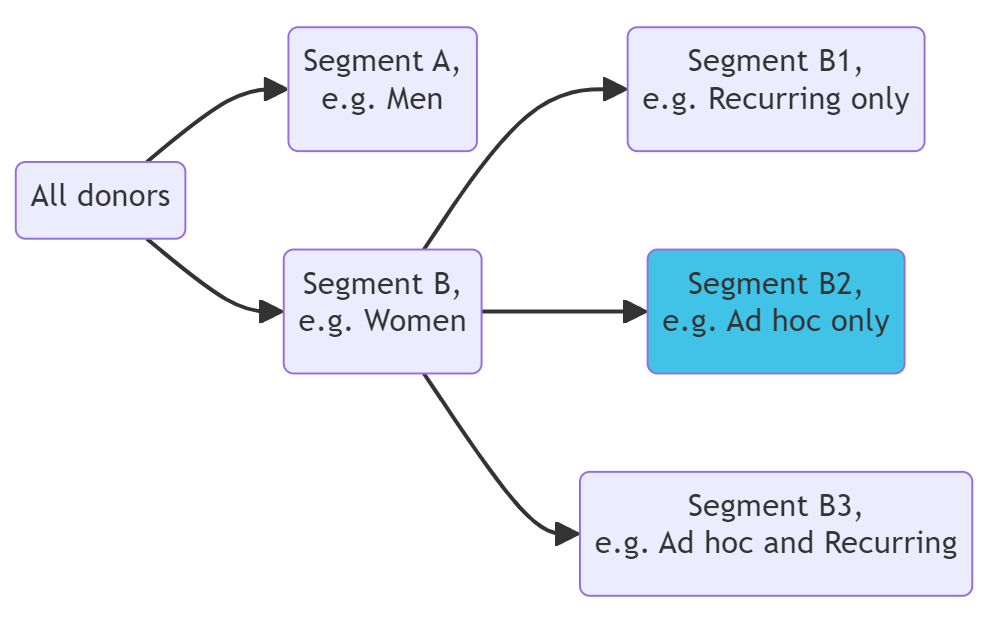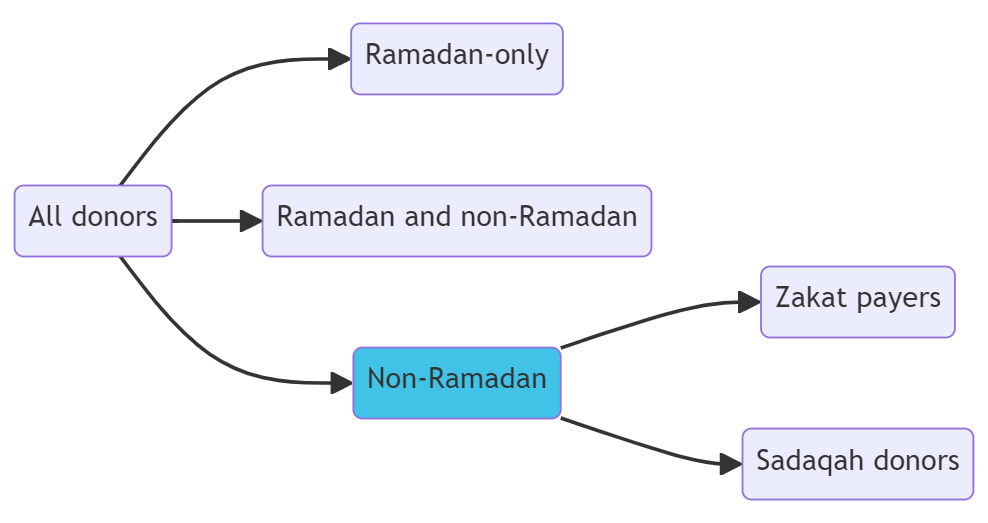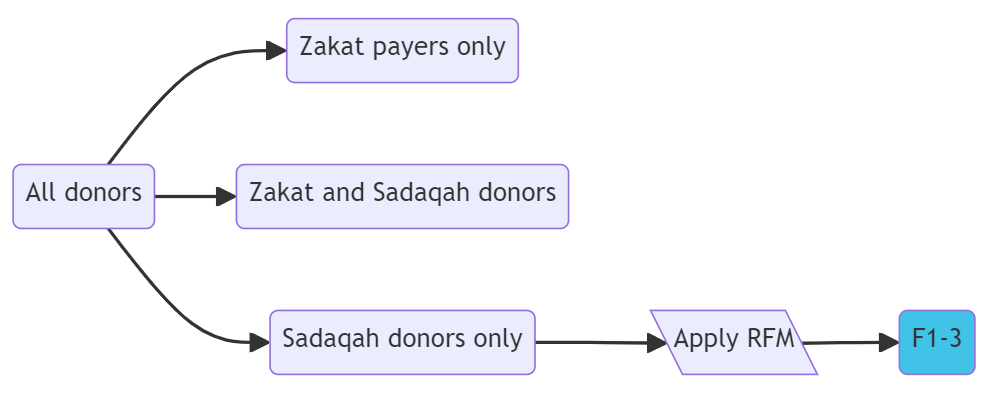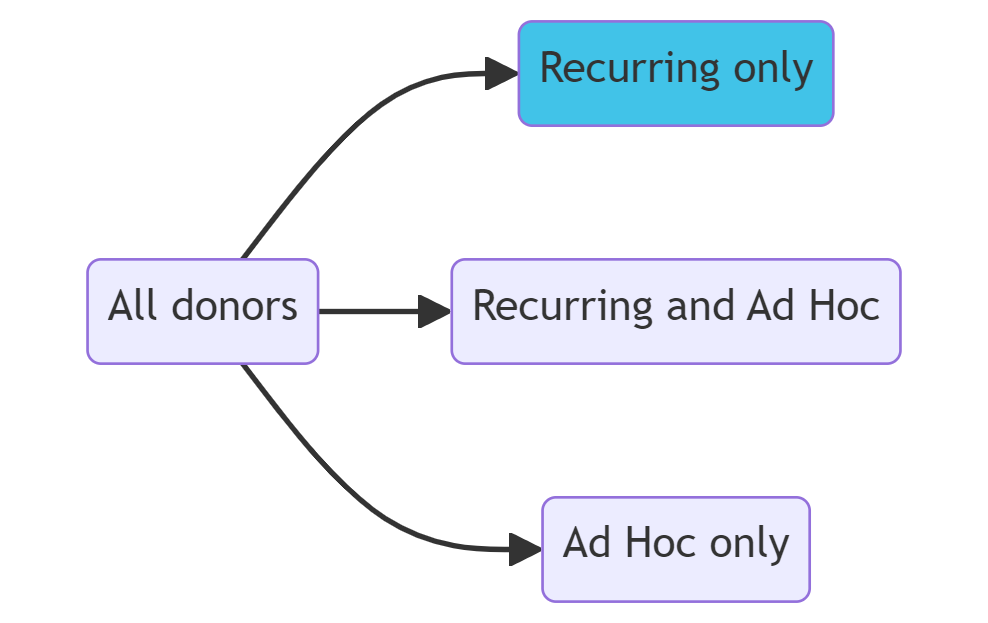Table of Contents
Who is this guide for?
If you have anything to do with how your charity/non-profit delivers its marketing content to donors, and you have a sizeable Muslim donor base, this Ramadan fundraising guide is for you.
If you send the same emails to the £5/month donor as the £10,000 ad hoc donor, then you need to stop right now and take on board some of the segmentation suggestions below.
What is donor segmentation and why should you do it?
Sending identical emails, mailshots or advertising the same content to all your donors - regardless of their past interactions with your charity - is not an optimal use of your budget.
By targeting different donor groups - based on their demographics or interaction history - with content that is most likely to engage with them, you are not only providing a better experience for them, but also maximising your return on investment.
Ramadan fundraising segmentation - an example

Here we create a Segment (B2) that is made up of female donors that donate via ad hoc payments rather than a recurring/direct debit instruction. This segment is made up by linking both demographic information and transaction history. If it is a sizeable proportion of your donor base, you may want to produce tailored content to engage this audience.
Why is Ramadan special for giving, and when is it?
Muslims will typically have a heightened state of spiritual consciousness during Ramadan, and believe that the benefits of good deeds carried out in month are amplified - so most Islamically-focused charities will get the majority of their donations during Ramadan. Muslims also calculate the Zakat (obligatory charitable giving, based on a person's wealth) that they need to pay at the same time each (Islamic) year, with most choosing the annual anniversary in Ramadan to do this.
Islam follows the lunar calendar, so Ramadan shifts around 11 days earlier every Gregorian year. In 2024 Ramadan is expected to start on 10 March.
Ramadan fundraising via paid ads is a lot more expensive than throughout the rest of the year for Muslim charities, so that's why we must do our best to optimise our audiences for each campaign. Let's take a look at some strategies you could implement:
Donor seasonality: Ramadan-only donors

The most obvious donor segment to target in your Ramadan fundraising strategy is donors who have only previously donated during Ramadan. These donors demonstrate the most extreme level of seasonality (perhaps even only donating in the last 10 nights of Ramadan, which are spiritually more significant).
These donors do not need to be told about the virtues of donating during Ramadan, so instead perhaps include information about how the previous year's Ramadan donations have been used.
You may find that donors that take part in automated donations spread across the last 10 nights donate more overall, in which case it may be worth segmenting donors who have donated 1 or less times during the last 10 nights of Ramadan and giving them information about your automated donations function across the last 10 nights.
Segmenting by geography

If organising iftars (breaking of the fast) or talks are part of your fundraising activities during Ramadan, make sure you prioritise who to send invitations to. For example, if you are organising one in Birmingham, it makes sense to send priority invitations to Birmingham residents that have made the largest monetary contributions first (M1-2). Perhaps send them both an email and paper invitation, before offering remaining spaces to other supporters.
Donor seasonality: Non-Ramadan donors

You may find some donors have never donated to you during Ramadan. Perhaps they have responded to your ad hoc appeals in the past (donating Sadaqah, which is voluntary charity) or they pay their Zakat to another organisation.
Some example strategies to deal with this group:
- The non-Zakat payers may not be aware that you offer a Zakat-compliant distribution fund
- Make the non-Zakat payers aware of the Zakat calculator and educational resources on your website, to help them calculate their liability
- Remind the non-Ramadan donors of the added benefits of charitable donations during Ramadan
RFM: Large Zakat payers that haven't paid recently

Zakat is paid on wealth, so generally this would not fluctuate wildly for most donors from one year to the next. However, it is possible that donors may have forgotten to calculate their Zakat or paid it to another organisation last year.
From our donors that have previously paid Zakat, we can apply an RFM filter to find our largest Zakat payers that have not donated recently. The parameters of the filter can be M=1 (largest monetary contributions) and R=4 (those assigned bottom score for recency, which will typically be donors who have last donated over a year ago).
Send these donors a reminder of their Zakat anniversary (use their last Zakat payment for this, but remember to use the Hijri calendar), and remind them of the impact their Zakat has had on its recipients.
RFM: Multiple-time donors that haven't paid Zakat

Multiple-time donors are already fantastic donors to have as supporters. However, for those that are eligible to pay Zakat, they may not be aware that some of your projects are eligible to receive Zakat funds.
Engage with these donors by pointing them to your online Zakat calculator, or information on how you deal with Zakat donations differently to Sadaqah.
Recurring donors that don't make ad hoc donations

You may have some donors that have set up Recurring/Direct Debit instructions but do not engage with ad hoc appeals. Recurring donors are great supporters - they help you budget expenditure by their regular giving, so always start your messages to them thanking them for exactly that. If you are in need of emergency funds (for example for a natural disaster), only talk about this after - specifically how their ad hoc donation will benefit the charity over and above their regular giving.
Segmenting by last Ramadan donation source

When creating audiences to target via paid channels, it is worth segmenting based on a donor's last donation source. You can even refine by one level further as to only take into account a donor's last Ramadan donation - since their social media habits may differ during this month. Perhaps they are more receptive to emails because they try and cut down time spent on Facebook? Remember people's sleeping habits also change in Ramadan, so use a tool to work out when best to engage with donors during Ramadan.
So as an example, if Donor A's last donation during the previous Ramadan resulted from an email campaign, that should be the first channel you use to engage with them this Ramadan.
Wrap-up
We've shown a series of donor segmentation techniques, applied to the real world use case of Ramadan fundraising.
With some extensive fiddling you can create these segments with some CRMs or even Excel (if you have several hours to spare) - but if you would like to see how they can be generated in just a few clicks, get in touch to see our award winning platform Giving Analytics in action.

